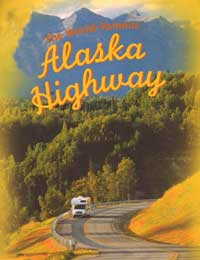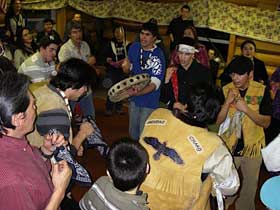
Post WWII History
Six months after the end of World War II, the Alaska Highway was handed over to Canada on April 1, 1946. Paving of the highway began in the 1960s, but it was still primarily gravel into the 1980s. It was not until the mid-1980s that the highway was completely paved from Dawson Creek to Delta Junction.
The highway is now used primarily for travel, shipping freight, and tourism. Large amounts of freight and material goods are trucked up and down the highway, making it the most heavily used highway in the North. Travel prior to the highway had been via dog sled, on foot, by riverboat to train, and horse. The highway connects distant communities and allows easier travel to economic centers such as Whitehorse, Yukon or Tok, Alaska.

Photo take from cover of "The World-Famous Alaska
Highway: A Guide to the Alcan & Other Wilderness Roads
of the North" by Tricia Brown
Tourism became popular soon after the highway was opened to the public in 1948, and people from all over the United States, Canada and over-seas came to drive, and experience the Alaska Highway.
Native Involvement with the Alaska Highway
In the PBS special, "American Experience -- Building the Alaska Highway," historian Ken Coates described the effect of the Alaska Highway on the areas Native population: "Construction projects transformed aboriginal life in the northwest very quickly and very profoundly. There was only occasional work to be found, they didn't hire very many aboriginal people to work. The women got involved selling handicrafts and doing some domestic work... There were a lot of attacks on aboriginal people, some rapes of Native women, for example. A lot of misuse of alcohol with aboriginal people. So, a world had ended. A lifestyle that had been in place in many ways for centuries, but certainly since the arrival of the fur traders in the middle of the 19th century. It's a hundred years of fishing, and trapping, and sort of casual engagement with the market economy, poof, gone. Overnight."

Photo courtesy of Gary Holton, Healy Lake Potlatch for Ellen Demit
Coates' description of the affect of the highway on the Native people is strikingly accurate. In their interviews, Laura Sanford, Charles Eikland and Babe Richards discuss the impact of the highway on First Nations and Alaska Natives in terms of religion, education and traditional culture. They talk specifically about the misunderstandings between Natives and whites, the loss of culture, residential schools and Native ways of life.
